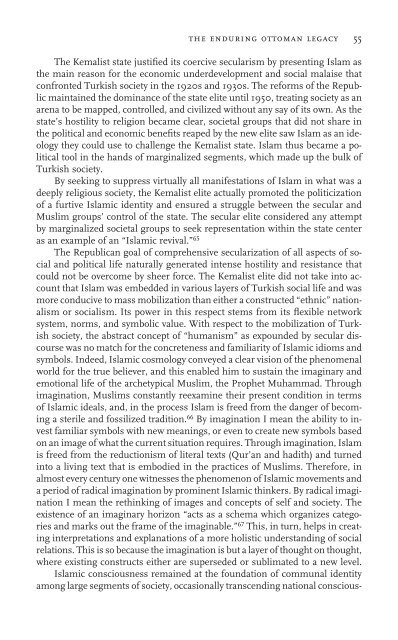You also want an ePaper? Increase the reach of your titles
YUMPU automatically turns print PDFs into web optimized ePapers that Google loves.
the endur<strong>in</strong>g ottoman legacy 55The Kemalist state justiWed its coercive secularism by present<strong>in</strong>g Islam asthe ma<strong>in</strong> reason for the economic underdevelopment and social malaise thatconfronted Turkish society <strong>in</strong> the 1920s and 1930s. The reforms of the Republicma<strong>in</strong>ta<strong>in</strong>ed the dom<strong>in</strong>ance of the state elite until 1950, treat<strong>in</strong>g society as anarena to be mapped, controlled, and civilized without any say of its own. As thestate’s hostility to religion became clear, societal groups that did not share <strong>in</strong>the political and economic beneWts reaped by the new elite saw Islam as an ideologythey could use to challenge the Kemalist state. Islam thus became a politicaltool <strong>in</strong> the hands of marg<strong>in</strong>alized segments, which made up the bulk ofTurkish society.By seek<strong>in</strong>g to suppress virtually all manifestations of Islam <strong>in</strong> what was adeeply religious society, the Kemalist elite actually promoted the politicizationof a furtive <strong>Islamic</strong> identity and ensured a struggle between the secular andMuslim groups’ control of the state. The secular elite considered any attemptby marg<strong>in</strong>alized societal groups to seek representation with<strong>in</strong> the state centeras an example of an “<strong>Islamic</strong> revival.” 65The Republican goal of comprehensive secularization of all aspects of socialand political life naturally generated <strong>in</strong>tense hostility and resistance thatcould not be overcome by sheer force. The Kemalist elite did not take <strong>in</strong>to accountthat Islam was embedded <strong>in</strong> various layers of Turkish social life and wasmore conducive to mass mobilization than either a constructed “ethnic” nationalismor socialism. Its power <strong>in</strong> this respect stems from its Xexible networksystem, norms, and symbolic value. With respect to the mobilization of Turkishsociety, the abstract concept of “humanism” as expounded by secular discoursewas no match for the concreteness and familiarity of <strong>Islamic</strong> idioms andsymbols. Indeed, <strong>Islamic</strong> cosmology conveyed a clear vision of the phenomenalworld for the true believer, and this enabled him to susta<strong>in</strong> the imag<strong>in</strong>ary andemotional life of the archetypical Muslim, the Prophet Muhammad. Throughimag<strong>in</strong>ation, Muslims constantly reexam<strong>in</strong>e their present condition <strong>in</strong> termsof <strong>Islamic</strong> ideals, and, <strong>in</strong> the process Islam is freed from the danger of becom<strong>in</strong>ga sterile and fossilized tradition. 66 By imag<strong>in</strong>ation I mean the ability to <strong>in</strong>vestfamiliar symbols with new mean<strong>in</strong>gs, or even to create new symbols basedon an image of what the current situation requires. Through imag<strong>in</strong>ation, Islamis freed from the reductionism of literal texts (Qur’an and hadith) and turned<strong>in</strong>to a liv<strong>in</strong>g text that is embodied <strong>in</strong> the practices of Muslims. Therefore, <strong>in</strong>almost every century one witnesses the phenomenon of <strong>Islamic</strong> movements anda period of radical imag<strong>in</strong>ation by prom<strong>in</strong>ent <strong>Islamic</strong> th<strong>in</strong>kers. By radical imag<strong>in</strong>ationI mean the reth<strong>in</strong>k<strong>in</strong>g of images and concepts of self and society. Theexistence of an imag<strong>in</strong>ary horizon “acts as a schema which organizes categoriesand marks out the frame of the imag<strong>in</strong>able.” 67 This, <strong>in</strong> turn, helps <strong>in</strong> creat<strong>in</strong>g<strong>in</strong>terpretations and explanations of a more holistic understand<strong>in</strong>g of socialrelations. This is so because the imag<strong>in</strong>ation is but a layer of thought on thought,where exist<strong>in</strong>g constructs either are superseded or sublimated to a new level.<strong>Islamic</strong> consciousness rema<strong>in</strong>ed at the foundation of communal identityamong large segments of society, occasionally transcend<strong>in</strong>g national conscious-




